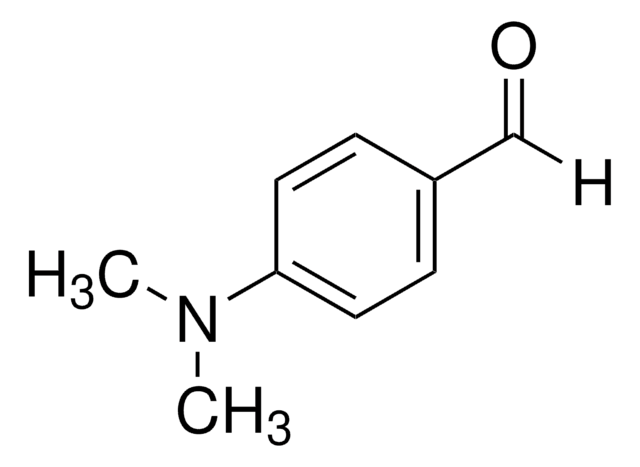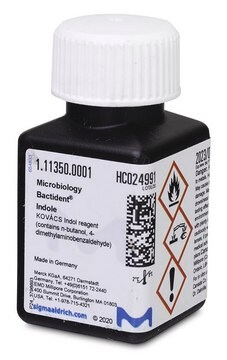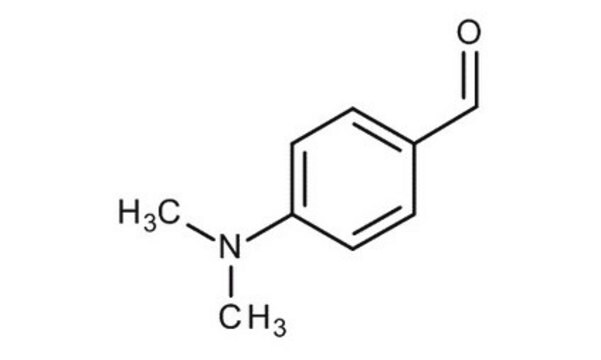Key Documents
60983
Kovac′s reagent for indoles
suitable for microbiology
Synonim(y):
4-(Dimethylamino)benzaldehyde solution, Indole reagent according to Kovac
About This Item
Polecane produkty
okres trwałości
limited shelf life, expiry date on the label
Poziom jakości
skład
n-butanol
4-dimethylaminobenzaldehyde
hydrochloric acid
metody
microbe id | specific enzyme detection: suitable
współczynnik refrakcji
n20/D 1.400-1.420
Zastosowanie
agriculture
clinical testing
environmental
food and beverages
microbiology
temp. przechowywania
2-8°C
przydatność
Escherichia coli
coliforms
ciąg SMILES
[H]C(=O)c1ccc(cc1)N(C)C
InChI
1S/C9H11NO/c1-10(2)9-5-3-8(7-11)4-6-9/h3-7H,1-2H3
Klucz InChI
BGNGWHSBYQYVRX-UHFFFAOYSA-N
Szukasz podobnych produktów? Odwiedź Przewodnik dotyczący porównywania produktów
Opis ogólny
Zastosowanie
Działania biochem./fizjol.
Hasło ostrzegawcze
Danger
Zwroty wskazujące rodzaj zagrożenia
Zwroty wskazujące środki ostrożności
Klasyfikacja zagrożeń
Acute Tox. 4 Oral - Eye Dam. 1 - Flam. Liq. 3 - Met. Corr. 1 - Skin Irrit. 2 - STOT SE 3
Organy docelowe
Central nervous system, Respiratory system
Kod klasy składowania
3 - Flammable liquids
Klasa zagrożenia wodnego (WGK)
WGK 1
Temperatura zapłonu (°F)
96.8 °F
Temperatura zapłonu (°C)
36 °C
Środki ochrony indywidualnej
Faceshields, Gloves, Goggles, type ABEK (EN14387) respirator filter
Wykazy regulacyjne
Wykazy regulacyjne dotyczą głównie produktów chemicznych. Można w nich podawać ograniczoną liczbę informacji na temat produktów niechemicznych. Brak wpisu oznacza, że żaden ze składników nie znajduje się w wykazie. Użytkownik odpowiada za zagwarantowanie bezpiecznego i zgodnego z prawem stosowania produktu.
EU REACH Annex XVII (Restriction List)
Wybierz jedną z najnowszych wersji:
Masz już ten produkt?
Dokumenty związane z niedawno zakupionymi produktami zostały zamieszczone w Bibliotece dokumentów.
Klienci oglądali również te produkty
Produkty
An article regarding the Role of Clostridium perfringens and their detection, identification, and differentiation from Sigma-Aldrich.com
For microbiologists the most fundamental stain was developed in 1884 by the Danish bacteriologist Hans Christian Gram.
Dla mikrobiologów najbardziej fundamentalny barwnik został opracowany w 1884 r. przez duńskiego bakteriologa Hansa Christiana Grama.
Sigma-Aldrich.com presents an article concerning Differentiation of Escherichia coli from coliforms.
Nasz zespół naukowców ma doświadczenie we wszystkich obszarach badań, w tym w naukach przyrodniczych, materiałoznawstwie, syntezie chemicznej, chromatografii, analityce i wielu innych dziedzinach.
Skontaktuj się z zespołem ds. pomocy technicznej












